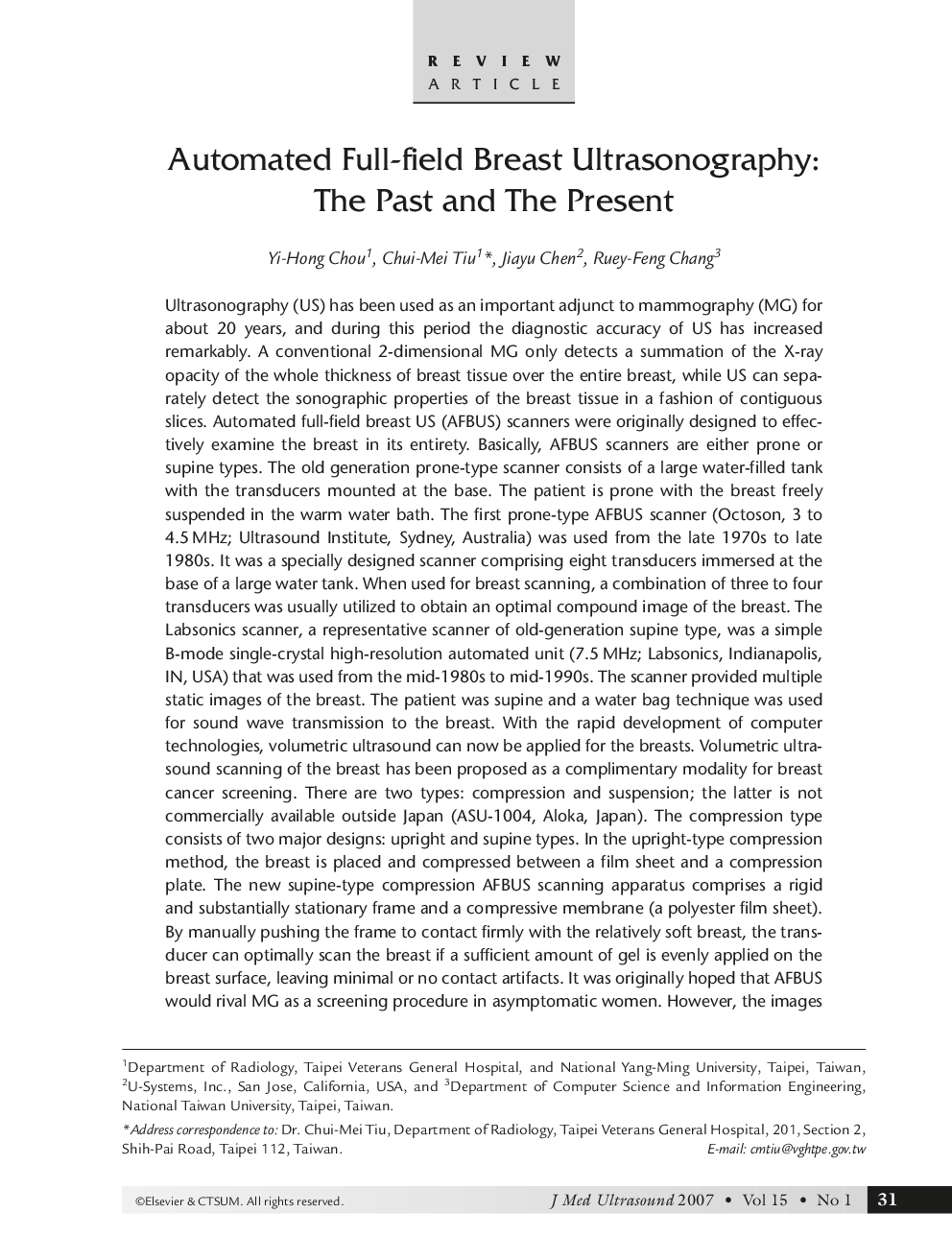| Article ID | Journal | Published Year | Pages | File Type |
|---|---|---|---|---|
| 4233388 | Journal of Medical Ultrasound | 2007 | 14 Pages |
Ultrasonography (US) has been used as an important adjunct to mammography (MG) for about 20 years, and during this period the diagnostic accuracy of US has increased remarkably. A conventional 2-dimensional MG only detects a summation of the X-ray opacity of the whole thickness of breast tissue over the entire breast, while US can separately detect the sonographic properties of the breast tissue in a fashion of contiguous slices. Automated full-field breast US (AFBUS) scanners were originally designed to effectively examine the breast in its entirety. Basically, AFBUS scanners are either prone or supine types. The old generation prone-type scanner consists of a large water-filled tank with the transducers mounted at the base. The patient is prone with the breast freely suspended in the warm water bath. The first prone-type AFBUS scanner (Octoson, 3 to 4.5 MHz; Ultrasound Institute, Sydney, Australia) was used from the late 1970s to late 1980s. It was a specially designed scanner comprising eight transducers immersed at the base of a large water tank. When used for breast scanning, a combination of three to four transducers was usually utilized to obtain an optimal compound image of the breast. The Labsonics scanner, a representative scanner of old-generation supine type, was a simple B-mode single-crystal high-resolution automated unit (7.5 MHz; Labsonics, Indianapolis, IN, USA) that was used from the mid-1980s to mid-1990s. The scanner provided multiple static images of the breast. The patient was supine and a water bag technique was used for sound wave transmission to the breast. With the rapid development of computer technologies, volumetric ultrasound can now be applied for the breasts. Volumetric ultrasound scanning of the breast has been proposed as a complimentary modality for breast cancer screening. There are two types: compression and suspension; the latter is not commercially available outside Japan (ASU-1004, Aloka, Japan). The compression type consists of two major designs: upright and supine types. In the upright-type compression method, the breast is placed and compressed between a film sheet and a compression plate. The new supine-type compression AFBUS scanning apparatus comprises a rigid and substantially stationary frame and a compressive membrane (a polyester film sheet). By manually pushing the frame to contact firmly with the relatively soft breast, the transducer can optimally scan the breast if a sufficient amount of gel is evenly applied on the breast surface, leaving minimal or no contact artifacts. It was originally hoped that AFBUS would rival MG as a screening procedure in asymptomatic women. However, the images obtained from the automated scanners of the old generation were of inferior quality to those generated by hand-held real-time scanners. Nevertheless, the current automated scanners equipped with high-frequency broadband transducers are still significantly competing with hand-held instruments. The current high-resolution AFBUS scanners can provide better demonstration of the breast anatomy and proper orientation and documentation of the lesions detected, and therefore better reproducibility and are good for follow-up studies. The volumetric data obtained can provide potential information for computer-aided detection and diagnosis of breast lesions. With current volumetric technologies, the AFBUS system can provide even higher detection rate of lesions including solid lesions and carcinomas. Interpretation of the imaging results from the volumetric AFBUS should be based on all the imaging data obtained. The current AFBUS scanners are easy to use and need only a short period of training, and the examination technique is especially suitable for technologists or sonographers to perform the whole scanning procedure. AFBUS may be used as an adjunct to MG or as baseline US examination of the breast and can play an important role in screening nonpalpable tumors in women with dense breasts. However, AFBUS in its current form cannot replace MG in detecting malignancy presenting as only microcalcifications.
